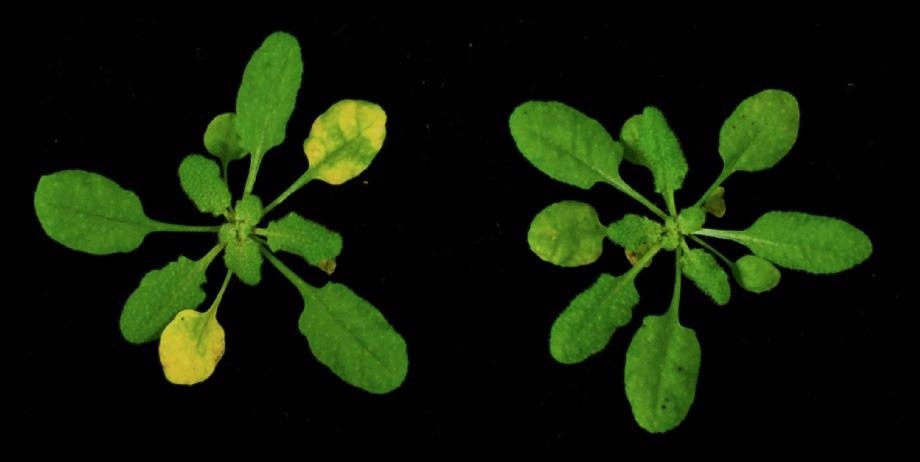A phone call, according to biologist Xinnian Dong, was her “best Christmas gift ever.” Pei Zhou, a longstanding friend, and partner at Duke University called with some exciting news: they had finally discovered the structure of the plant protein NPR1.
 When exposed to pathogens, the common lab plant A. thaliana relies on a defense protein called NPR1 to stay healthy (right). Plants that lack NPR1 (left) become infected and develop yellow leaves. Image Credit: Raul Zavaliev/Duke University
When exposed to pathogens, the common lab plant A. thaliana relies on a defense protein called NPR1 to stay healthy (right). Plants that lack NPR1 (left) become infected and develop yellow leaves. Image Credit: Raul Zavaliev/Duke University
NPR1 was identified twenty-five years ago by Dong, a Howard Hughes Medical Institute Investigator. The protein, named after Dong’s love of National Public Radio, plays an important role in defending blooming plants from a variety of diseases. NPR1 is now well-known as a master regulator that regulates over 2,000 genes involved in plant immunity.
Despite its important role in plant defense, NPR1’s structure has remained unknown, much to the dismay of scientists. Researchers have struggled to comprehend how the protein controls plant protection due to a lack of comprehensive structure data, according to Zhou.
What’s really crucial and missing is an explanation of how NPR1 works on a molecular level.”
Pei Zhou, Duke University
Zhou and Dong’s group have bridged that gap in their new study, which reveals how NPR1 looks and behaves, a discovery that could revolutionize plant breeding. On May 11, 2022, the two groups published a paper in Nature detailing the structure of NPR1 from the common lab plant Arabidopsis thaliana.
The paper is the culmination of Dong’s decades-long research.
When I first saw the structure of NPR1, it took my breath away. It looked like a gliding bird, just beautiful.”
Xinnian Dong, Biologist, Duke University
Plants that are fighting fit
Humans have had to combat pests and viruses that hinder plant growth for as long as they have farmed crops. One of the most renowned villains is the water mold Phytophthora infestans, which was accountable for the Irish Potato Famine, which culminated in a million deaths and two million refugees. “It’s a huge struggle that has shaped our world,” says Dong.
Pathogens proceed to wreak havoc on bananas, avocados, and other popular crops now. Conventional techniques for solving the problem, on the other hand, can be troublesome. For instance, chemical pesticides are frequently hazardous to the environment.
One reason plant breeders are turning to genetic treatments, such as modifying plant cells to produce large quantities of NPR1, is to address this problem. The strategy has worked in the lab and limited field experiments, but there is a catch: as immunity rises, growth decreases.
According to Jonathan Jones, a plant biologist at the Sainsbury Laboratory in Norwich, UK, who was not enrolled in the research, the newfound understanding of NPR1’s structure and function should help researchers avoid this problem and build better crops.
Understanding how the protein works and interacts with other molecules has considerable potential to be very powerful for enhancing disease resistance in plants.”
Jonathan Jones, Plant Biologist, Sainsbury Laboratory
A bird with unfurled wings
Zhou, Dong, and his colleagues to determine the structure of NPR1, used x-ray crystallography and the imaging method cryo-electron microscopy (cryo-EM). Jijie Chai, a structural biologist at the University of Cologne who was not engaged with the research, notes that many labs have tried but failed over the years. “NPR1 is notoriously difficult to purify for imaging,” he says.
The team’s success was due to the complimentary use of the techniques. The scientists used cryo-EM to obtain an initial structure of NPR1, which provided critical information on how to prepare the protein for crystallography. As a result, high-resolution pictures of NPR1 and its critical functional areas have been obtained.
While former studies presented hints into parts of NPR1’s structure, none have been “as comprehensive as reported in this new paper,” Jones says. Two NPR1 proteins come together in the new photos to form a structure that mimics a bird with spread wings. NPR1 interacts with chemicals in the cell nucleus at the wingtips, activating plant immune genes, according to Dong’s research. “Four years of experimentation was well worth the wait,” she says.
Her team is now trying to figure out how NPR1 changes structure when it is activated by an infection. “This study not only addressed many long-standing questions but also points to new research directions,” Dong says. “It’s an exciting time.”
Source:
Journal reference:
Kumar, S., et al. (2022) Structural basis of NPR1 in activating plant immunity. Nature. doi.org/10.1038/s41586-022-04699-w.